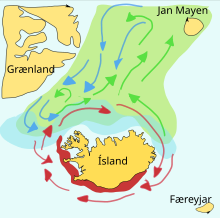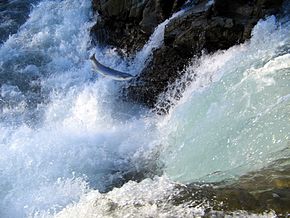Fish migration
The bull shark is a euryhaline species that moves at will from fresh to salt water, and many marine fish make a diel vertical migration, rising to the surface to feed at night and sinking to lower layers of the ocean by day.George S. Myers coined the following terms in a 1949 journal article: Although these classifications originated for fish, they can apply, in principle, to any aquatic organism.List of diadromous orders and families, and the number of known species:[9][11] Forage fish often make great migrations between their spawning, feeding and nursery grounds.The capelin move inshore in large schools to spawn and migrate in spring and summer to feed in plankton rich areas between Iceland, Greenland and Jan Mayen.[13] The term highly migratory species (HMS) has its origins in Article 64 of the United Nations Convention on the Law of the Sea (UNCLOS).These high trophic level oceanodromous species undertake migrations of significant but variable distances across oceans for feeding, often on forage fish, or reproduction, and also have wide geographic distributions.Traditional genetic markers such as short-range PCR products, microsatellites and SNP-arrays have struggled to identify population structure and distinguish fish stocks from separate ocean basins.An example of a euryhaline species is the bull shark, which lives in Lake Nicaragua of Central America and the Zambezi River of Africa.Diel vertical migration is a common behavior; many marine species move to the surface at night to feed, then return to the depths during daytime.A number of large marine fishes, such as the tuna, migrate north and south annually, following temperature variations in the ocean.The Mx gene family is expressed at high levels in the blood and intestine during development, suggesting they are a key to immune defense for the growing fish.The idea that these genes play an important role in development against viruses suggests they are critical in the trout's success in an anadromous lifestyle.



Anadromesalmonmass relocationbody of waterschools of fishforage fishcannibalismUnited Nations Convention on the Law of the Seapelagic fishexclusive economic zonesstriped bassbull sharkeuryhalinediel vertical migrationConnecticut Riversea lampreyGeorge S. MyersClassical GreekCyclostomiLampreysGeotriidaeMordaciidaePetromyzontidaeChondrosteiAcipenseriformesSturgeonsElopomorphaElopiformesElopidaeTarponsAnguillidaeMoray eelsOphichthidaeOtocephalaClupeiformesClupeidaeAnchoviesPristigasteridaeCypriniformesCyprinidaeCharaciformesCitharinidaeCatfishAriidaeBagridaeClaroteidaeShark catfishEeltail catfishSchilbeidaeProtacanthopterygiiGalaxiidaeSalmonidaeStomiatiOsmeriformesSmeltsPlecoglossidaeRetropinnidaeSalangidaeParacanthopterygiiGadiformesGadidaeLotidaePercomorphaOvalentariaAmbassidaeAtheriniformesOld World silversidesNeotropical silversidesGobiesocidaeGobiiformesEleotridaeGobiidaeRhyacichthyidaeMugilidaeFlatfishPleuronectidaeSyngnathiformesSyngnathidaeTetraodontiformesTetraodontidaeCarangiformesCarangidaeMoroniformesMoronidaeAcanthuriformesSciaenidaeScorpaeniformesCottidaeSticklebacksScorpaenidaeTetraroginaeTrachiniformesCheimarrichthyidaePerciformesLutjanidaeCentropomidaeMojarrasHaemulidaeFlagtailsLateolabracidaeLatidaeTemperate perchsPercidaePseudaphritidaeTerapontidaeArcherfishcapelinSardine runNorwayIcelandAtlanticArcticplanktoncrustaceansGreenlandJan Mayenocean currentsspawninglarvalhigh seasStraddling stockBonn Conventionalbacorebluefinbigeye tunaskipjack
